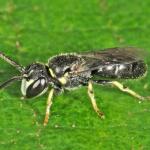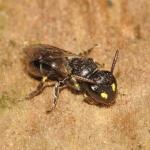Prosopis varipes SMITH 1853; Prosopis excisa SCHENCK 1853; Hylaeus vicinus FÖRSTER 1871; Hylaeus melanarius FÖRSTER 1871; Hylaeus claripennis FÖRSTER 1871; Hylaeus panzeri FÖRSTER 1871; Sphex annulata PANZER 1798; Prosopis aquisgraneis DALLA TORRE 1896; Prosopis pictipes var. nigriscutum ALFKEN 1913
Southern England and North to Shropshire. Generally, a rare species. Widely distributed in Europe, Anatolia, the Caucasus, the Middle East and North Africa (Koster 1986).
Not listed in Shirt (1987). Falk (1991) lists this bee as a Notable A species, now known as Nationally Scarce (Na).
Open woodland, fens, coastal dunes and shingle, and occasionally urban gardens.
Univoltine; mid June to late August.
Nests have been found in burrows in bramble (Rubus) and rose (Rosa) stems. Others were located in the vacated burrows of Anobium punctatum in dead gorse stems in Kent (pers. obs.).
Bramble (Rubus fruticosus agg.), a cabbage (Brassica sp.), a crane’s-bill (Geranium sp.), hogweed (Heracleum sphondylium), a mignonette (Reseda sp.) and sheep’s-bit (Jasione montana).
The chalcid wasp Coelopencyrtus arenarius has been reared from nests in dead gorse stems collected by G H L Dicker at Dungeness, East Kent.
Proofed: January 2012



